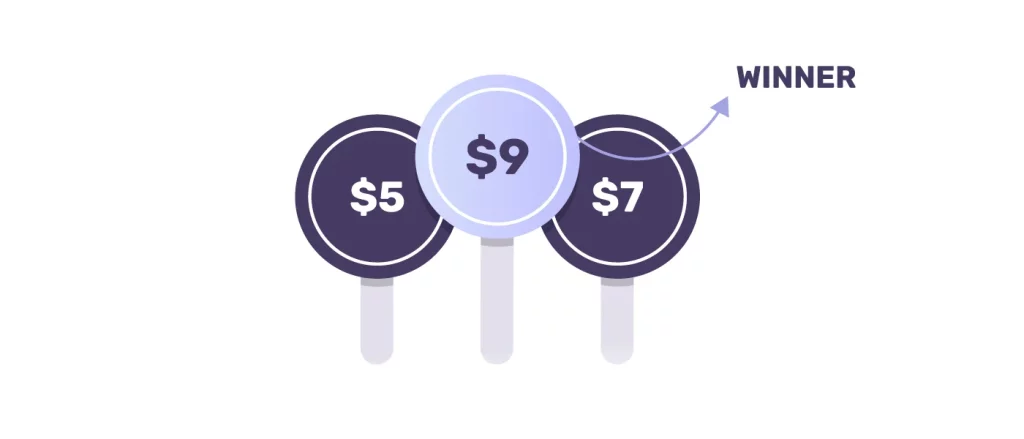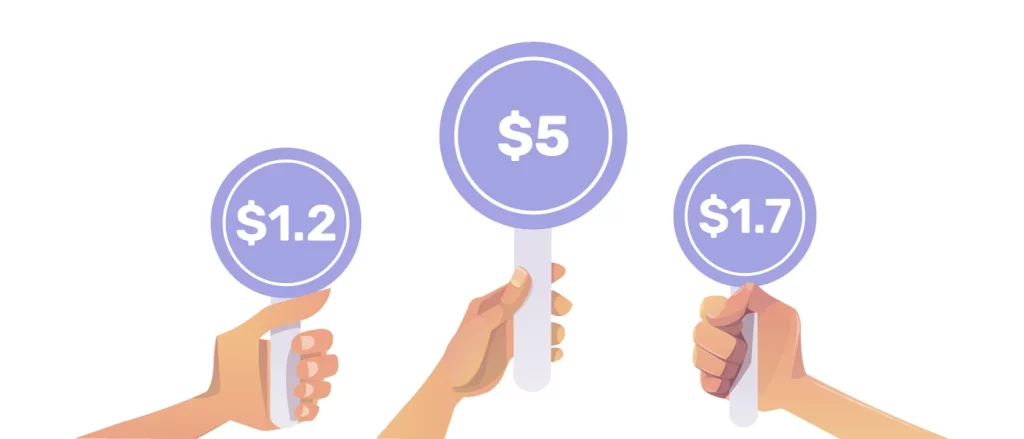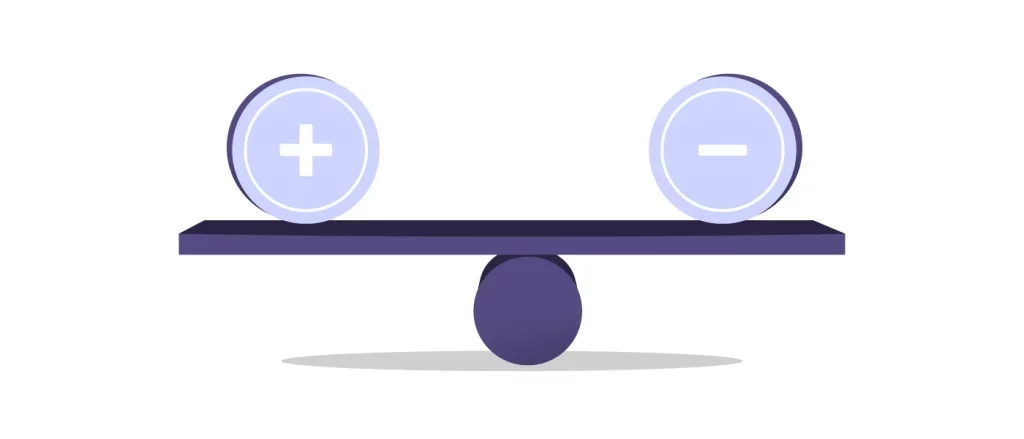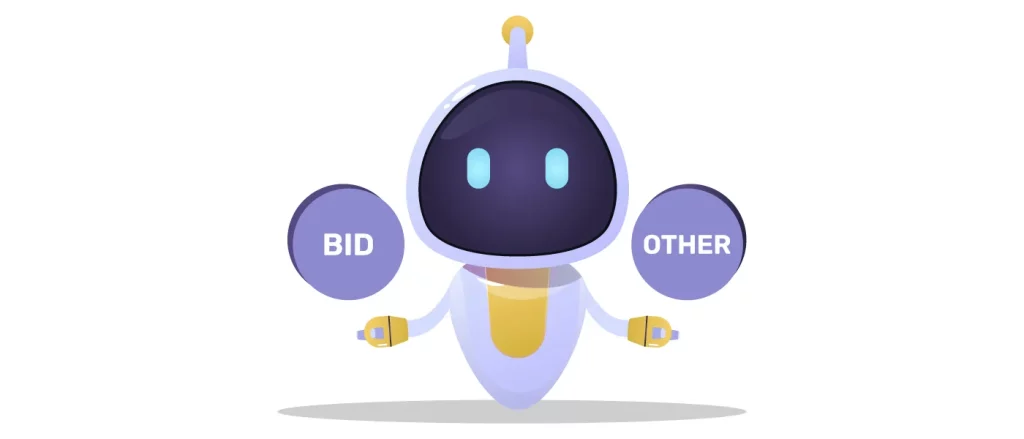Bid Shading Meaning and How It Impacts Ad Spend
Bid shading sounds technical (and it kind of is), but if you’re buying media programmatically, it’s something you can’t ignore.
First-price auctions have become the new norm in programmatic advertising. And unlike second-price auctions, they don’t give you any built-in safety net. The bid is too high, and you pay every cent. The bid is too low, and you lose the impression. It’s a lose-lose setup without some form of bid control.
That’s where bid shading comes in. It’s an algorithmic tactic that helps advertisers avoid overpaying while still winning auctions.
This article explains bid shading in plain English: what it is, how it works, and why it matters. Whether searching for the meaning of bid shading or just trying to stay competitive in a first-price environment, this guide breaks it down.
Table of Contents
What Is Bid Shading?

Bid shading is a programmatic advertising tactic that helps advertisers avoid overpaying in first-price auctions.
Instead of paying the full bid amount every time, a demand-side platform or DSP (and some supply-side platforms or SSPs) uses an algorithm to predict the lowest amount likely to win an impression based on historical auction data and real-time market signals. This action results in your actual bid getting adjusted (or “shaded”) down just enough to stay competitive without spending more than necessary.
In simple terms, you’re still bidding in a first-price environment, but the algorithm estimates a more efficient bid based on prior data. While the auction is still first-price, bid shading simulates some of the savings you’d have seen under second-price rules by reducing your bid before it enters the auction.
Wondering where bid shading actually happens? Get clear on how Open Exchanges work →
Why Was Bid Shading Introduced?
Bid shading was introduced out of necessity. Before 2018, second-price auctions were the industry standard. Advertisers would bid their maximum but pay just enough to beat the next highest bidder. It was predictable, budget-friendly, and relatively fair.
Then came the shift to first-price auctions, where the highest bid pays exactly what they bid. It didn’t take long for buyers to notice something was off. So, what’s changed?
Buyers suddenly faced much higher costs when the industry shifted from second-price to first-price auctions. In the old model, you could bid high to stay competitive, knowing you’d only pay a penny more than the second-highest bid. But once first-price auctions took over, your bid became the price tag. That meant advertisers bidding $8 were paying $8, even if the next-best offer was only $5. The shift caused a spike in CPMs and put massive pressure on ad budgets.
DSPs and agencies needed a way to adjust without compromising campaign performance. Bid shading became the answer, allowing advertisers to maintain aggressive bidding strategies while softening the financial impact.
By analyzing historical clearing prices, win rates, and contextual data, DSPs could fine-tune bids to land just above the threshold needed to win, often trimming several percent off the average cost. In an environment where every cent counts, especially at scale, bid shading quickly evolved from a nice-to-have feature to a core programmatic necessity.
How Does It Work in a First-Price Auction Environment?
In a first-price auction, your bid is precisely what you pay if you win. That’s a significant shift from second-price setups, where you’d only pay just enough to beat the second-highest bid. Bid shading steps in to bridge that gap.
Here’s how it works behind the scenes:
- Historical Auction Data: Your DSP pulls past performance data, including clearing prices, win rates, time of day, user devices, and even the specific website or app.
- Price Prediction: Using that data, the algorithm estimates the “likely winning bid.” It aims for a number just above the historical average needed to win, not your full max bid.
- Automatic Shading: The DSP adjusts your bid downward (aka “shades” it) to align with that predicted price. The goal is to win without overpaying.
- Real-Time Bidding: Your shaded bid enters the auction. If it wins, great. You will pay less than you would with your original bid. If not, the algorithm takes note and adjusts next time.
So, while it feels automatic on the surface, it’s a real-time learning loop. The algorithm keeps refining its shading based on results, keeping your bids competitive but cost-effective.
Many buyers prefer using a DSP’s bid shading tool over the exchange’s, as DSPs can analyze data across multiple SSPs and offer a more comprehensive view of auction dynamics. That broader scope often leads to more optimized bid adjustments. Still, SSP-side shading can be beneficial in some cases, mainly when the exchange provides deeper insight into publisher-side data. A mix of both strategies is often the most effective.
Bid shading only makes sense when you know how auctions actually work. Understand First vs. Second-Price Auctions →
Bid Shading Explained: Buyers or Sellers?
Bid shading is primarily a buy-side strategy, so we will discuss it more in the DSP context, but it’s not exclusive to buyers. Most DSPs (like Google DV360 and The Trade Desk) offer built-in bid shading tools to help advertisers reduce costs in first-price auctions.
However, some ad exchanges and SSPs also use bid shading. Certain exchanges introduced shading features to support advertisers during the industry’s shift away from second-price auctions. Surprisingly, even SSPs (for example, PubMatic) have integrated bid shading into their platforms.
Independent bid shading solutions are also available for advertisers who want more flexibility beyond their DSPs’ default tools.
So, while bid shading started as a buy-side tool, it’s now part of a broader strategy that involves both sides of the ad supply chain.
Want to see which DSPs offer the best built-in bid shading? Check out the top Demand-Side Platforms →
But Do Publishers Benefit from It?
While bid shading is designed for buyers, publishers can still benefit indirectly. Even with reduced bids, the final price is typically higher than what would have cleared under a second-price auction.
Moreover, while bid shading can reduce publisher earnings per impression, it helps attract buyers by making bidding more efficient. Publishers don’t sell inventory without buyer demand, so supporting smarter bidding can protect long-term revenue flow.
So, in theory, publishers still receive substantial payouts, even as buyers earn efficiency.
Why Bid Shading Became Essential in Programmatic Advertising

Bid shading became essential in programmatic advertising as a direct response to the industry-wide switch to first-price auctions. From 2019 to 2020, major ad exchanges (Google AdX, Index Exchange, OpenX, and others) abandoned second-price auctions in favor of first-price models. That shift forced advertisers to rethink their bidding strategies almost overnight.
Under second-price logic, brands could bid aggressively but only pay slightly more than the next-highest bidder. With that cushion gone, advertisers started paying the full bid amount every time, and CPMs jumped sharply.
To regain cost control, DSPs introduced bid shading. It served as a workaround that mimicked the safety net of second-price bidding. Instead of overpaying, advertisers could rely on algorithms to estimate the lowest amount likely to win each auction and shade their bids accordingly. This made campaign pacing more stable and prevented budgets from getting torched in the first few days of flight.
Efficiency also played a significant role. Shaded bids helped preserve historical performance benchmarks. Agencies didn’t need to reinvent every KPI or completely overhaul their strategy. They just layered in shading and kept their campaigns running with fewer surprises.
Early adopters of bid shading reported measurable improvements in cost-efficiency, while those who ignored it risked bleeding spend in high-volume environments. What started as a reactive solution quickly became baked into nearly every DSP’s toolkit.
Bid shading is most common in open marketplaces, so understanding how they function is critical. Learn how Programmatic Open Exchange really works →
Bid Shading in Practice
Setting it up involves typically toggling a universal shading switch, choosing aggressive or conservative modes, or customizing shade percentages by deal type (open exchange vs. private marketplace). Some platforms let you drill down by site or audience segment (more control, more complexity).
Bid Sahding Workflow:
- Campaign Setup
Choose your max bid and turn on bid shading.
- Mode Selection
Pick an algorithmic preset (e.g., “balanced,” “aggressive savings,” or “max win rate”).
- Monitoring
Track your average CPM and win rate shifts in dashboard reports.
- Tweak & Optimize
If you’re losing too many auctions, dial back shading; if you’re winning but CPMs are high, nudge shading up.
Advantages & Disadvantages of Bid Shading

Bid Shading Advantages
- Lower CPMs Without Losing Reach: Advertisers using bid shading often see 5–15% cost savings per impression, which is not pocket change, especially at scale.
- Better Budget Control: Shaded bids help campaigns stay on pace without burning through budgets in the first week, giving you more predictability and less volatility.
- No Manual Adjustments Needed: Once enabled, the algorithm handles the math. There is no need to micromanage every campaign. Just check the dashboard and optimize as needed.
- Competitive Edge in Crowded Auctions: While others overspend or underbid, shaded bids ride the sweet spot (high enough to win, low enough to protect ROI).
Bid Shading Disadvantages
- Transparency Issues: Not all DSPs show how the shading algorithm works. You’re trusting the black box, which can make optimization harder if things go sideways.
- Can Undercut Publishers: From the publisher’s perspective, shading can make it feel like buyers are gaming the system. It often means lower yield unless countered with dynamic pricing strategies.
- Over-Shading Risk: If your DSP shades too aggressively, you might lose out on key inventory, especially during high-demand periods or in niche verticals.
- Not One-Size-Fits-All: Bid shading works differently across open exchange PMPs and deals with fixed floors. What saves money in one campaign might underperform in another.
Bid shading is just one part of the bigger programmatic puzzle. Discover how Programmatic Display really works →
Bid Shading vs. Other Programmatic Strategies

1. Bid Shading vs. Manual Bid Adjustments
Manual adjustments mean you (or your team) are actively tweaking bids based on performance data. It’s hands-on, time-consuming, and prone to human error.
- Manual = Control, but slow and reactive;
- Bid shading = Automation with real-time logic.
If you manage massive campaigns, bid shading wins on scalability.
2. Bid Shading vs. Dynamic CPM (dCPM)
dCPM automatically adjusts your cost per thousand impressions based on predicted performance (viewability, clicks, or conversions). It’s more performance-based than auction-based.
- dCPM = Outcome-focused;
- Bid shading = Auction-focused.
Use dCPM if you’re chasing ROI or viewability goals. Use bid shading to cut costs without hurting reach in first-price auctions.
3. Bid Shading vs. Floor Price Targeting
Floor price targeting is when publishers set a minimum price they’re willing to accept. Advertisers try to avoid bidding below that to prevent losing the auction.
But here’s the problem: floor prices can shift quietly. You might keep losing without knowing why. Bid shading adapts in real-time, often predicting where the floor is and slipping right above it. It’s sneakier (in a good way).
4. Bid Shading vs. Supply Path Optimization (SPO)
SPO is about choosing the most direct and cost-efficient path to the same inventory (e.g., avoiding multiple middlemen). While SPO focuses on where your bid travels, bid shading focuses on how much you pay. Here, you can best use both SPO to avoid markups and bid shading to avoid overpaying.
Bid shading is part of optimizing your path to inventory, but are you optimizing the supply path too? Learn about Supply Path Optimization →
FAQ
Not necessarily. Well-tuned shading targets just above the historical clearing price, so win rates stay high while costs drop.
Bid shading is commonly used by agencies and brands that run programmatic ad campaigns. It’s beneficial for anyone aiming to improve CPM efficiency without sacrificing reach.
In many cases, bid shading is included as part of a DSP’s core offering at no added cost. However, some platforms monetize shading by taking a percentage of the savings it generates or including it in broader platform fees. For example, The Trade Desk’s KOA may apply a pricing structure based on performance gains. Reviewing your DSP’s fee model to understand whether shading is truly free is best.
Not really. Most DSPs treat bid shading algorithms as proprietary, so how bids are adjusted is usually hidden. Some offer limited controls, but complete transparency is rare. There’s growing pressure for more visibility, though it’s still mostly a black box.
Publishers can’t completely block bid shading in open auctions, but they can counteract it through dynamic floor pricing, optimized header bidding wrappers, and yield management tools. In private marketplaces (PMPs) or direct deals, publishers have more control and can set fixed prices or minimums that reduce the impact of bid shading.
Track win rate dips; you might be overshading if you lose more than ~5–10% of auctions without a significant CPM drop.
Final Thoughts
Now, you’ve got a clearer picture of bid shading, how it works, and why it matters in programmatic advertising. Whether you’re optimizing campaigns or just trying to stop overspending in first-price auctions, knowing how shading fits into the process gives you a real edge.
Keep an eye on how your platform handles it, and don’t be afraid to ask questions if the details feel like a black box.
Keep in mind that bid shading algorithms vary by platform. Some DSPs use basic rulesets, while others leverage machine learning that adapts in real-time based on win rates, time of day, or device type. More advanced platforms may even allow you to customize how aggressive or conservative the shading is. Understanding your platform’s capabilities is key to getting the most out of shading.